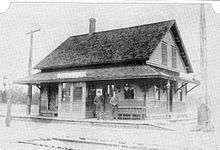North Wilmington station
North Wilmington is an MBTA Commuter Rail station in North Wilmington, Massachusetts. It serves the Haverhill Line, and is located off Middlesex Avenue (MA-62). It has some of the most limited station faculties on the MBTA system - a single short bare platform serving the line's single track at the location, with a small parking lot and single bus shelter for passengers - but is a stop for all trains on the line. North Wilmington station is not accessible.
North Wilmington | |||||||||||
|---|---|---|---|---|---|---|---|---|---|---|---|
An inbound train at North Wilmington in August 2015 | |||||||||||
| Location | 370 Middlesex Avenue Wilmington, Massachusetts | ||||||||||
| Coordinates | 42.5696°N 71.1597°W | ||||||||||
| Line(s) | Western Route | ||||||||||
| Platforms | 1 side platform | ||||||||||
| Tracks | 1 | ||||||||||
| Construction | |||||||||||
| Parking | 20 spaces (free) | ||||||||||
| Other information | |||||||||||
| Fare zone | 3 | ||||||||||
| History | |||||||||||
| Opened | July 1, 1845 December 19, 1979[1] | ||||||||||
| Closed | June 14, 1959[2] | ||||||||||
| Traffic | |||||||||||
| Passengers (2018) | 58 (weekday average boardings)[3] | ||||||||||
| Services | |||||||||||
| |||||||||||
History

The Boston and Maine Railroad Extension opened on July 1, 1845 from Wilmington Junction to Boston, allowing the Boston and Maine Railroad a route into the city not dependent on the rival Boston and Lowell Railroad. A two-story wooden station was located at North Wilmington on the north side of Middlesex Avenue next to the northbound track, with a small shelter next to the southbound track.[4] The station building was destroyed in a fire caused by a defective chimney on October 26, 1914.[5] A small station building was constructed to replace it.
On June 14, 1959 the section from Reading to Wilmington Junction became freight-only, and Haverhill commuter trains as well as intercity service from New Hampshire and Maine were rerouted over the Wildcat Branch and the lower Lowell Line.[2] The Salem Street stop on the Wildcat Branch opened to replace North Wilmington on the mainline.[1]
The lone remaining Haverhill trip was discontinued in June 1976. During the 1979 energy crisis, service was restored to Haverhill via the pre-1959 route, with several intermediate stops including North Wilmington returned to service.[1][2] Unlike the stops that had kept service until the 1970s, there was little left at North Wilmington. Like the similarly hastily built stations opened soon after on the Fitchburg Line, North Wilmington received a low asphalt platform and a small parking area, with a bus shelter added for passengers. Because the platform is close to Route 62, trains block the road when stopped, which causes delays for emergency services. In 2018, the MBTA agreed to consider near-term changes as well as a later station reconstruction to fix the problem.[6] A plan was made in 1992 to move the platform to allow emergency vehicles to drive around the crossing gates when a train was stopped, but the platform was not moved.[7]
References
- Belcher, Jonathan. "Changes to Transit Service in the MBTA district" (PDF). NETransit.
- Humphrey, Thomas J. & Clark, Norton D. (1985). Boston's Commuter Rail: The First 150 Years. Boston Street Railway Association. pp. 55–70. ISBN 9780685412947.
- Central Transportation Planning Staff (2019). "2018 Commuter Rail Counts". Massachusetts Bay Transportation Authority.
- "Burlington & Wilmington & Woburn". George H. Walker & Co. 1889. Retrieved 28 August 2015.
- Butters, Albert D.; Foote, George F. (1915). "Fire Engineers' Report". Wilmington, Mass. Annual Report of the Town's Officers for the Financial Year Ending December 31, 1914. C. M. Barrows Co. p. 143 – via Internet Archive.
- LaCrosse, Mike (July 18, 2018). "Wilmington First Responders Worried About Train That Blocks Busy Intersection". CBS Boston (WBZ-TV).
- "Wilmington News Briefs" (PDF). Wilmington Town Crier. July 23, 1992. p. 7 – via Wilmington Library.
External links
| Wikimedia Commons has media related to North Wilmington station. |